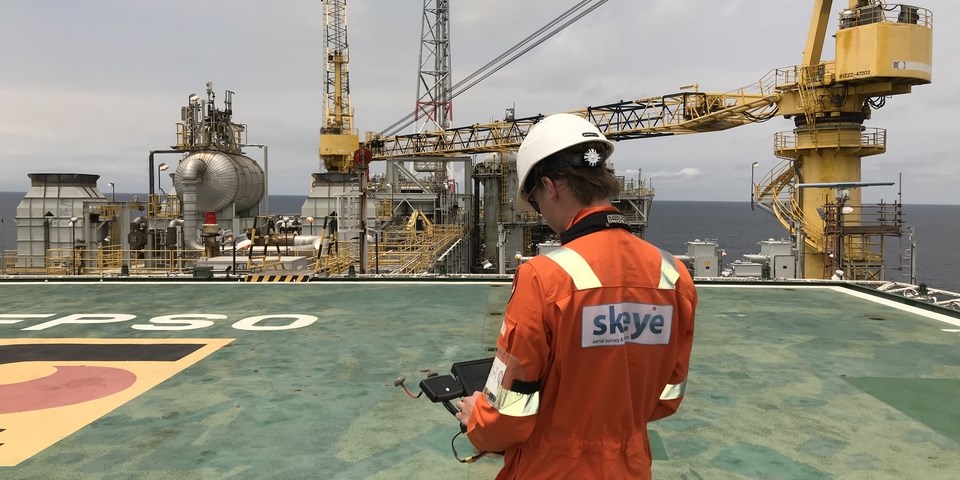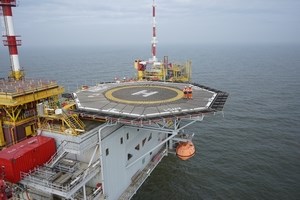Skeye in action on a large FPSO off the coast of Angola. The company for now does not inspect valves. Franken states that it could be possible (leak detection) but for now there haven’t been client requests in this area.
Article by Lucien Joppen
___
It is fair to say that the drone inspection business is still in its infancy. One of the major players in Europe, British-Dutch Skeye, was established in 2012. Founder/co-owner Pieter Franken: “I came into contact with drones and their commercial potential back in 2012. After some initial tests I decided to start my own company which in 2016 merged with Skycap from Britain. At the moment we operate a fleet of more than 15 drones in different types and capabilities.”
Franken, just back from a trip to Nigeria, has just signed an agreement with Shell to monitor some of its projects over the world, also in Nigeria. According to him, the agreement could be a breakthrough in oil and gas. “We have been working up to the agreement for more than three years. Understandably, Shell wanted to make sure that our drones, drone operators and organization are working to their strict standards. This process takes time.”
As for the rest of the oil and gas industry, Franken says some companies have expressed an interest in Skeye’s services, but only after Shell more or less decided to use drones for inspection purposes. “The acceptation of most new technologies is generally slow. Most companies are looking at each other and waiting for a first mover who ideally would weed out the start-up problems. We and also our competitors initially have underestimated the reluctance within the industry in general. Only recently, it seems that the industry is more ready to act rather than expressing a general interest.”
This reluctance also stemmed from various developments within the field of legislation, Franken says. Because the use of drones for commercial purposes is a relative new development using various technologies that are rapidly evolving, legislation typically follows technology. “There is also a lot of confusion -still within the industry what is allowed and what not”, Franken states.
“It does not help that for drones below 150 kg there are national legislations in place which can vary considerably per country. In some countries, the use of drones for inspection services is very strict. In other regions, both legislation and enforcement are considered weak. There are however efforts, coordinated by the EASA (European Aviation Safety Agency) to harmonize legislation within the EU, a development which the drone (operating) industry endorses.”
Lower costs
As stated before, drone inspection is here to stay and to grow in the years to come. A major driver for growth is a lower cost structure compared to manual inspection. Also the safety factor comes into play.
Mostly drones are employed for inspections of equipment (parts) that are difficult to reach. For example, flares in petrochemical installations or hulls/underdecks/top sides in FPSO’s or platforms. One company – K2 Dronotics -claims that a drone could inspect 12 off shore flares in just six days, thereby increasing the number of inspections and subsequently reducing inspection costs and flare replacement costs.
The other pro of drones is their ability to inspect and detect with greater detail than the human eye. Drones are able to shoot high-res images and use infrared camera’s to detect differences in warmth to 1/10th of a degree.
“Holes in flares/flare stacks typically tend to clog which lead to uneven heat patterns which speed up wear and tear. It is very difficult to spot these clogs with the human eye or a camera.” Apart from visual inspections, drones could also be equipped with sensors that would be able to ‘sniff’ gas leaks. Franken states he has seen equipment at trade shows which would be able to do the job. The price tag for this equipment – around 80.000 euro – is hefty and the capabilities/scope of the equipment still needs to be tested in industry settings, Franken says.
Human factor
Apart from the advantages, drones also have their limitations. Franken would be the first to acknowledge this. Unlike a human inspector drones are not able to take a screw driver or some epoxy resin to carry out light repairs or maintenance. “Drones can only detect. Based on these data, it is up to human experts to analyze and possibly act. In most cases, human intervention is needed but with the data gathered by drone inspection, these interventions can be planned more efficiently.”
In short, drones and drone operators will not be the be-all and end-all but merely take some of the inspection work away from humans, Franken says. “A drone is not a silver bullet. The human factor remains very important for assessment and repair/ maintenance.”
___
When asked about the potential of drone inspection, various numbers circulate. It is fair to say these are highly speculative – ranging from 14 to 28 billion USD in 2022/2025 – and also encompass drone services in general. Apart from industrial inspection, drones are also used for measuring (for example volumes of iron ore or coal) or visualization such as 360 views from a 20 story building that still has to be built.
For industrial inspections, two types of drones or UAV (unmanned aerial vehicles) are in use: helicopter and airplane. The latter are typically for inspection which cover greater areas and requite longer flight times. Inspections are carried out mostly beyond the visional line of sight (BVOL). Helicopter-type drones – available in various types – are used for shorter inspections of industrial equipment, mostly within visual line of sight. Both drone types have potential for the oil and gas industry. For example, Shell will employ BVOL-drones for inspection of the Australian Charlie-LNG-project, covering more than 725 kilometers of water and gas gathering pipelines.



